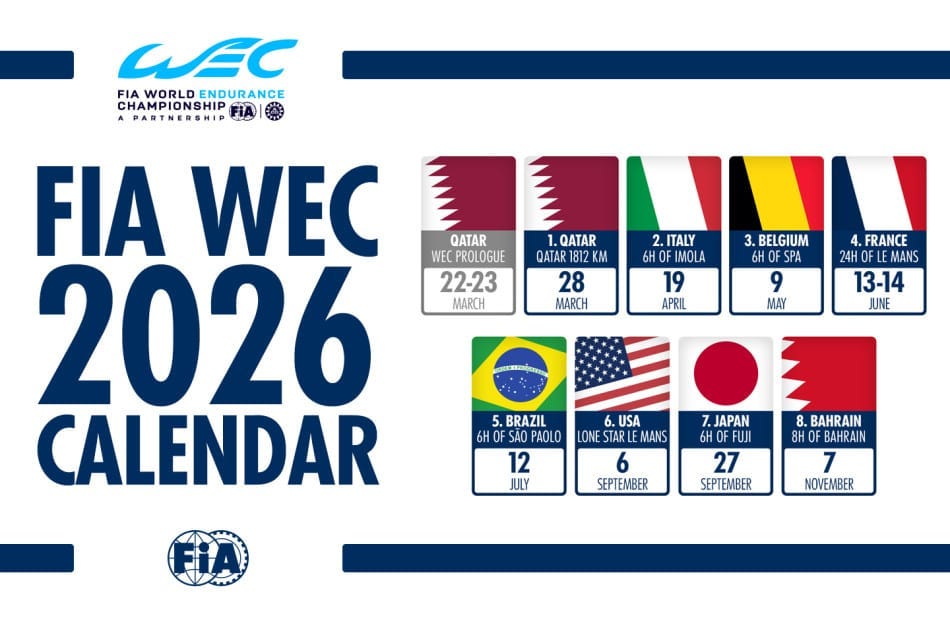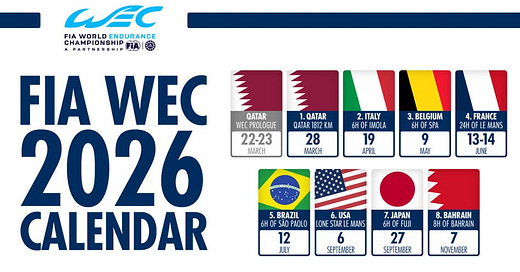
The FIA World Endurance Championship will stay exactly where it is – literally. The governing body has copied the successful 2025 blueprint and pasted it into 2026, confirming an eight-round world tour that begins in Qatar, ends in Bahrain and touches five regions along the way. At the same time, the FIA World Motor Sport Council has added three extra years to the Hypercar homologation cycle, extending the top-class ruleset to the close of the 2032 season.
For teams, factories and fans alike, the message is stability. FIA president Mohammed Ben Sulayem called the calendar “proof of the championship’s incredible growth and global reach”, while WEC CEO Frédéric Lequien praised “a winning formula we have no desire to tinker with”.
The eight-round world tour
DateEventVenueRegion22-23 MarchOfficial PrologueLusail, QatarMiddle East26-28 MarchQatar 1812 kmLusail, QatarMiddle East17-19 April6 Hours of ImolaItalyEurope7-9 May6 Hours of Spa-FrancorchampsBelgiumEurope10-14 June24 Hours of Le MansFranceEurope10-12 July6 Hours of São PauloBrazilSouth America4-6 SeptemberLone Star Le MansAustin, USANorth America25-27 September6 Hours of FujiJapanAsia-Pacific5-7 November8 Hours of BahrainSakhir, BahrainMiddle East
The 93rd running of Le Mans sits on the same weekend as Formula 1’s Barcelona Grand Prix.
The only contract news hidden in the fine print is a fresh multi-year extension for Imola, which now runs at least to 2028 and comes with a pledge for extra pit garages and paddock upgrades. Elsewhere, the event order and race distances mirror 2025 to the lap.
Why copy-and-paste?
Continuity sells tickets. Every 2026 venue set an attendance record in 2024 or 2025.
Cost certainty. Teams can roll over freight budgets and spares packages, which is crucial when sea freight costs remain volatile.
Broadcast rhythm. Broadcasters and streaming platforms can lock in prime-time slots a full year earlier.
The timing is perfect for the Automobile Club de l’Ouest, which owns Le Mans. Another stable calendar underpins ticket sales for the Centenary-plus-two running of the 24 Hours, already trending ahead of the 325,000 crowd in 2024.
Hypercar rules frozen to 2032
Originally due to expire in 2029, the LMH/LMDh regulations will now govern WEC’s halo class until the end of 2032. FIA Endurance Commission president Richard Mille said the move “balances global exposure with sensible budgets”.
12 brands have raced Hypercars since 2021.
Eight (Alpine, Aston Martin, BMW, Cadillac, Ferrari, Peugeot, Porsche and Toyota) are on the 2025 grid.
Genesis is publicly committed for 2026, with Ford and McLaren evaluating 2027 entries.
Under the carry-over rules, each constructor may upgrade aero once and hybrid power-train hardware once in the eight-year window. Software, control maps and “joker” reliability parts remain open each season, keeping performance creep in check while allowing headline efficiency gains, good news for road-car marketing teams.
What it means for the German power bloc
Porsche
Targeting a record 20th Le Mans win in 2025 with three factory 963s and a customer Proton entry.
Continuity means Weissach can bankroll a mid-cycle EVO kit rather than gamble on an all-new chassis.
Sister brand Manthey keeps three 911 GT3 R cars in LMGT3.
BMW
Two M Hybrid V8s stay in Hypercar; the EVO M4 GT3 debuts in LMGT3.
New M2 Racing programme graduates from Nürburgring testing to customer sales in 2026.
Mercedes-AMG
Returns to Le Mans after 26 years with three “Silver Arrow” LMGT3s run by Iron Lynx.
Stuttgart’s management hint the homologation extension “makes a Hypercar feasibility study far more attractive”.
Long-run rules remove the biggest board-level objection; writing off a £100 million racer after just four years, and open the door for customer Hypercars, a concept several OEMs quietly lobby for.
Winners and watch-points
Winners
Manufacturers: Develop once and sell for six seasons.
Privateers: No sudden obsolescence for million-euro chassis.
Circuits: Assured event dates attract long-term sponsors.
Watch-points
Le Mans-F1 clash: ACO insists no change, but drivers with parallel contracts face hard choices.
Grid size: 2025’s 21-car Hypercar entry tests pit-lane capacity in Qatar and Fuji; the series may need to cap entries or add garages.
Performance BOP: eight more seasons of convergence will stretch Balance-of-Performance spreadsheets – and tempers.
RSR take
We have lived through boom-and-bust WEC calendars: the globe-trotting 2012-14 era, the post-diesel contraction, the COVID chaos. Copying 2025 wholesale is not lazy, it is sane. Series bosses know that fans follow storylines, and storylines need the same stages.
The Hypercar extension is even bigger news. Endurance racing finally has its version of Formula 1’s turbo-hybrid era: a stable rule-book, a clear marketing pitch (“race what you sell, sell what you race”) and a realistic runway for new entrants. Expect the paddock chatter at Le Mans next week to centre not on who will win in 2025, but who will sign off a Hypercar for 2028-30.


